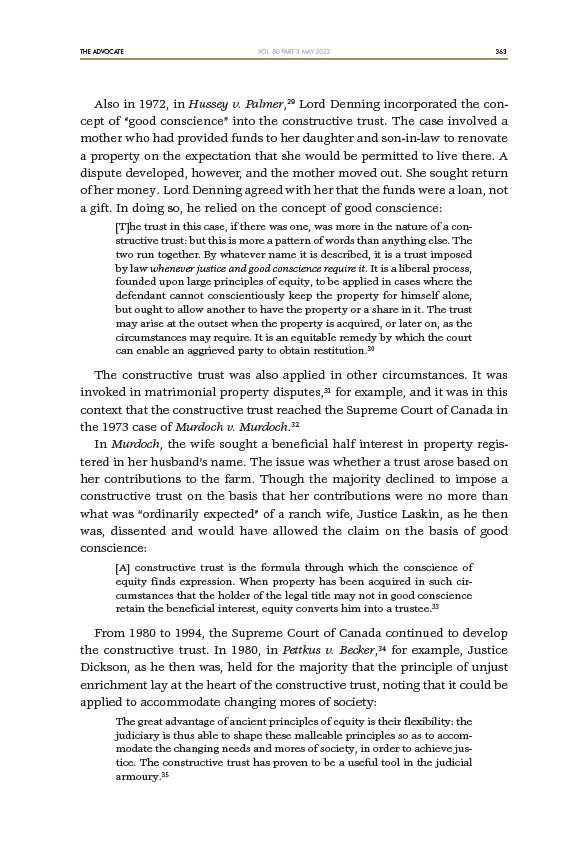
THE ADVOCATE 363
VOL. 80 PART 3 MAY 2022
Also in 1972, in Hussey v. Palmer,29 Lord Denning incorporated the concept
of “good conscience” into the constructive trust. The case involved a
mother who had provided funds to her daughter and son-in-law to renovate
a property on the expectation that she would be permitted to live there. A
dispute developed, however, and the mother moved out. She sought return
of her money. Lord Denning agreed with her that the funds were a loan, not
a gift. In doing so, he relied on the concept of good conscience:
The trust in this case, if there was one, was more in the nature of a constructive
trust: but this is more a pattern of words than anything else. The
two run together. By whatever name it is described, it is a trust imposed
by law whenever justice and good conscience require it. It is a liberal process,
founded upon large principles of equity, to be applied in cases where the
defendant cannot conscientiously keep the property for himself alone,
but ought to allow another to have the property or a share in it. The trust
may arise at the outset when the property is acquired, or later on, as the
circumstances may require. It is an equitable remedy by which the court
can enable an aggrieved party to obtain restitution.30
The constructive trust was also applied in other circumstances. It was
invoked in matrimonial property disputes,31 for example, and it was in this
context that the constructive trust reached the Supreme Court of Canada in
the 1973 case of Murdoch v. Murdoch.32
In Murdoch, the wife sought a beneficial half interest in property registered
in her husband’s name. The issue was whether a trust arose based on
her contributions to the farm. Though the majority declined to impose a
constructive trust on the basis that her contributions were no more than
what was “ordinarily expected” of a ranch wife, Justice Laskin, as he then
was, dissented and would have allowed the claim on the basis of good
conscience:
A constructive trust is the formula through which the conscience of
equity finds expression. When property has been acquired in such circumstances
that the holder of the legal title may not in good conscience
retain the beneficial interest, equity converts him into a trustee.33
From 1980 to 1994, the Supreme Court of Canada continued to develop
the constructive trust. In 1980, in Pettkus v. Becker,34 for example, Justice
Dickson, as he then was, held for the majority that the principle of unjust
enrichment lay at the heart of the constructive trust, noting that it could be
applied to accommodate changing mores of society:
The great advantage of ancient principles of equity is their flexibility: the
judiciary is thus able to shape these malleable principles so as to accommodate
the changing needs and mores of society, in order to achieve justice.
The constructive trust has proven to be a useful tool in the judicial
armoury.35